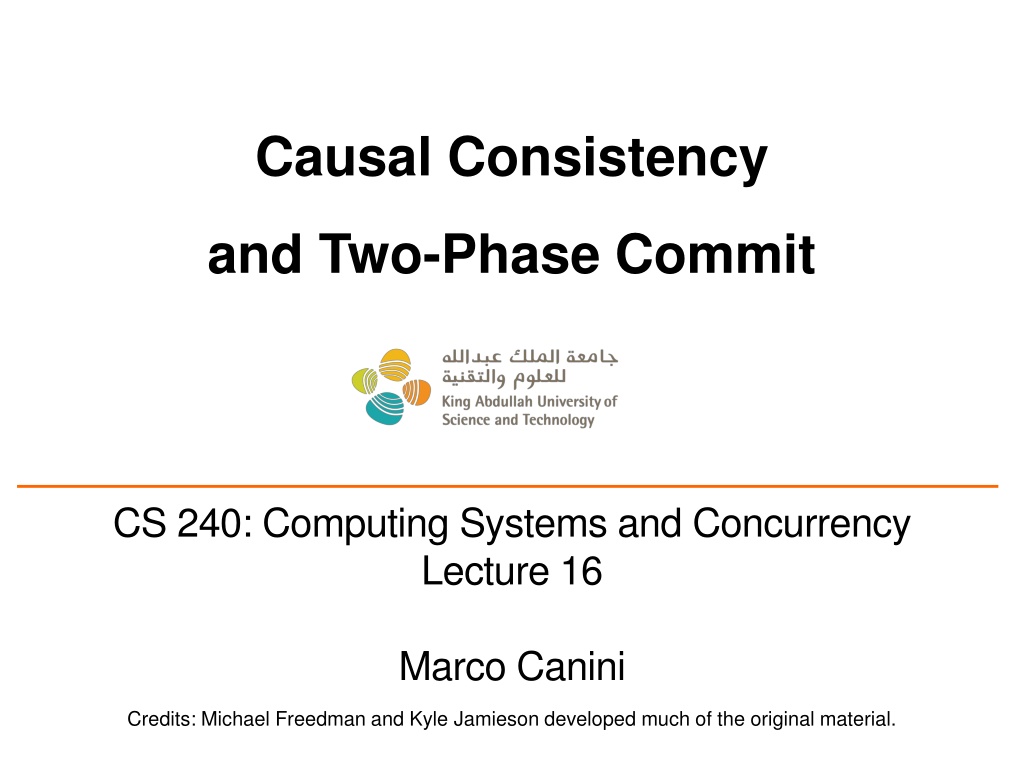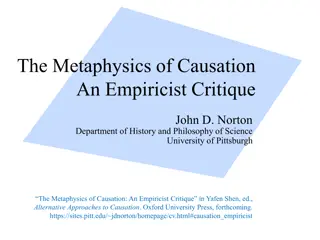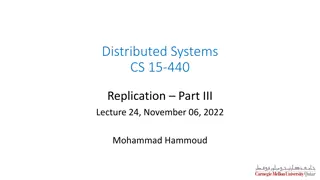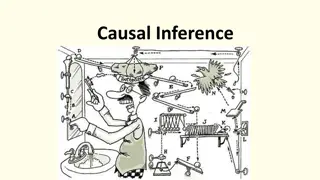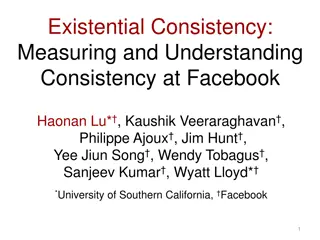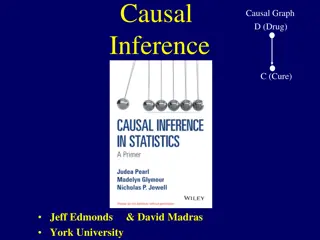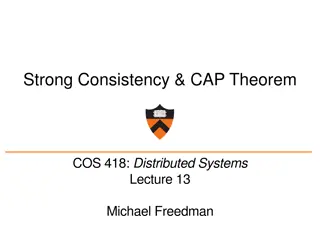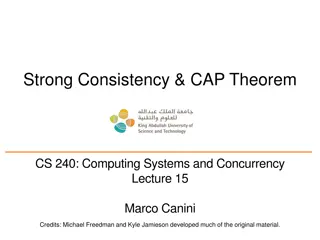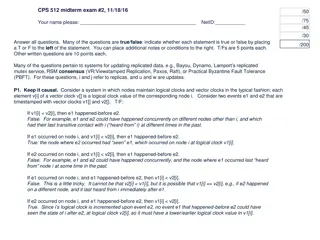Understanding Causal Consistency in Distributed Systems
This content covers the concept of causal consistency in computing systems, exploring consistency models such as Causal Linearizability and Eventual Sequential. It explains the importance of logical clocks like Lamport and vector clocks, and how they ensure order in distributed systems. The concept is illustrated with examples like a distributed bulletin board application, emphasizing the ordering of potentially causally related writes. The material also includes quizzes to distinguish between valid scenarios under causal consistency compared to sequential consistency.
Download Presentation

Please find below an Image/Link to download the presentation.
The content on the website is provided AS IS for your information and personal use only. It may not be sold, licensed, or shared on other websites without obtaining consent from the author. Download presentation by click this link. If you encounter any issues during the download, it is possible that the publisher has removed the file from their server.
E N D
Presentation Transcript
Causal Consistency and Two-Phase Commit CS 240: Computing Systems and Concurrency Lecture 16 Marco Canini Credits: Michael Freedman and Kyle Jamieson developed much of the original material.
Consistency models Causal Linearizability Eventual Sequential 2
Recall use of logical clocks (lec 5) Lamport clocks: C(a) < C(z) Conclusion: None Vector clocks: V(a) < V(z) Conclusion: a z Distributed bulletin board application Each post gets sent to all other users Consistency goal: No user to see reply before the corresponding original message post Conclusion: Deliver message only after all messages that causally precede it have been delivered 3
Causal Consistency 1. Writes that are potentially causally related must be seen by all machines in same order. 2. Concurrent writes may be seen in a different order on different machines. Concurrent: Ops not causally related
Causal Consistency 1. Writes that are potentially causally related must be seen by all machines in same order. P1 P3 P2 a b f c 2. Concurrent writes may be seen in a different order on different machines. d e g Concurrent: Ops not causally related Physical time
Causal Consistency P1 P3 P2 Operations Concurrent? a b a, b N f b, f Y c c, f Y d e, f Y e e, g N g a, c Y a, e N Physical time
Causal Consistency P1 P3 P2 Operations Concurrent? a b a, b N f b, f Y c c, f Y d e, f Y e e, g N g a, c Y a, e N Physical time
Causal Consistency: Quiz Valid under causal consistency Why? W(x)b and W(x)c are concurrent So all processes don t (need to) see them in same order P3 and P4 read the values a and b in order as potentially causally related. No causality for c .
Sequential Consistency: Quiz Invalid under sequential consistency Why? P3 and P4 see b and c in different order But fine for causal consistency B and C are not causally dependent Write after write has no dep s, write after read does
Causal Consistency x A: Violation: W(x)b is potentially dep on W(x)a B: Correct. P2 doesn t read value of a before W
Causal consistency within replication systems 11
Implications of laziness on consistency shl Consensus Module State Machine Consensus Module State Machine Consensus Module State Machine Log Log Log add jmp mov shl add jmp mov shl add jmp mov shl Linearizability / sequential: Eager replication Trades off low-latency for consistency 12
Implications of laziness on consistency shl State Machine State Machine State Machine Log Log Log add jmp mov shl add jmp mov shl add jmp mov shl Causal consistency: Lazy replication Trades off consistency for low-latency Maintain local ordering when replicating Operations may be lost if failure before replication 13
Motivation: sending money send_money(A, B, amount) { Begin_Transaction(); if (A.balance - amount >= 0) { A.balance = A.balance - amount; B.balance = B.balance + amount; Commit_Transaction(); } else { Abort_Transaction(); } } 15
Single-server: ACID Atomicity: all parts of the transaction execute or none (A s decreases and B s balance increases) Consistency: the transaction only commits if it preserves invariants (A s balance never goes below 0) Isolation: the transaction executes as if it executed by itself (even if C is accessing A s account, that will not interfere with this transaction) Durability: the transaction s effects are not lost after it executes (updates to the balances will remain forever) 16
Distributed transactions? Partition databases across multiple machines for scalability (A and B might not share a server) A transaction might touch more than one partition How do we guarantee that all of the partitions commit the transactions or none commit the transactions? 17
Two-Phase Commit (2PC) Goal: General purpose, distributed agreement on some action, with failures Different entities play different roles in the action Running example: Transfer money from A to B Debit at A, credit at B, tell the client okay Require both banks to do it, or neither Require that one bank never act alone This is an all-or-nothing atomic commit protocol Later will discuss how to make it before-or-after atomic 18
Straw Man protocol 1. C TC: go! Client C go! Transaction Coordinator TC Bank A B
Straw Man protocol 1. C TC: go! Client C A: debit $20! B: credit $20! C: okay 2. TC TC TC go! okay Transaction Coordinator TC A, B perform actions on receipt of messages Bank A B
Reasoning about the Straw Man protocol What could possibly go wrong? 1. Not enough money in A s bank account? 2. B s bank account no longer exists? 3. A or Bcrashes before receiving message? 4. The best-effort network to B fails? 5. TC crashes after it sends debit to A but before sending to B? 21
Safety versus liveness Note that TC, A, and B each have a notion of committing We want two properties: 1. Safety If onecommits,no one aborts If oneaborts,no one commits 2. Liveness If no failures and A and B can commit, action commits If failures, reach a conclusion ASAP 22
A correct atomic commit protocol 1. C TC: go! Client C go! Transaction Coordinator TC Bank A B
A correct atomic commit protocol 1. C TC: go! Client C 2. TC A, B: prepare! Transaction Coordinator TC prepare! prepare! Bank A B
A correct atomic commit protocol 1. C TC: go! Client C 2. TC A, B: prepare! P: yes or no 3. A, B Transaction Coordinator TC Bank A B
A correct atomic commit protocol 1. C TC: go! Client C 2. TC A, B: prepare! P: yes or no 3. A, B Transaction Coordinator TC A, B: commit! or abort! 4. TC TC sends commit if both say yes TC sends abort if either say no commit! commit! Bank A B
A correct atomic commit protocol 1. C TC: go! Client C 2. TC A, B: prepare! okay P: yes or no 3. A, B Transaction Coordinator TC A, B: commit! or abort! 4. TC TC sends commit if both say yes TC sends abort if either say no 5. TC C: okay or failed Bank A B A, B commit on receipt of commit message
Reasoning about atomic commit Why is this correct? Neither can commit unless both agreed to commit What about performance? 1. Timeout: I m up, but didn t receive a message I expected Maybe other node crashed, maybe network broken 2. Reboot: Node crashed, is rebooting, must clean up 28
Timeouts in atomic commit Where do hosts wait for messages? TCwaits for yes or no from A and B 1. TChasn t yet sent any commit messages, so can safely abort after a timeout But this is conservative: might be network problem We ve preserved correctness, sacrificed performance A and Bwait for commit or abort from TC 2. If it sent a no, it can safely abort(why?) If it sent a yes, can it unilaterally abort? Can it unilaterally commit? A, B could wait forever, but there is an alternative 29
Server termination protocol Consider Server B (Server A case is symmetric) waiting for commit or abort from TC Assume B voted yes (else, unilateral abort possible) B A: status? A then replies back to B. Four cases: 1. (No reply from A): no decision, B waits for TC 2. Server A received commit or abort from TC: Agree with the TC s decision 3. Server Ahasn t voted yet or voted no: both abort TCcan t have decided to commit 4. Server A voted yes: both must wait for the TC TC decided to commitif both repliesreceived TC decided to abort if it timed out 30
Reasoning about the server termination protocol What are the liveness and safety properties? Safety: if servers don t crash and network between A and B is reliable, all processes reach the same decision (in a finite number of steps) Liveness: if failures are eventually repaired, then every participant will eventually reach a decision Can resolve some timeout situations with guaranteed correctness Sometimes however A and B must block Due to failure of the TC or network to the TC But what will happen if TC, A, or Bcrash and reboot? 31
How to handle crash and reboot? Can t back out of commit if already decided TC crashes just after sending commit! A or B crash just after sending yes If all nodes knew their state before crash, we could use the termination protocol Use write-ahead log to record commit! and yes to disk 32
Recovery protocol with non-volatile state If everyone rebooted and is reachable, TC can just check for commit record on disk and resend action TC: If no commit record on disk, abort You didn t send any commit! messages A, B: If no yes record on disk, abort You didn t vote yes so TCcouldn t have committed A, B: If yes record on disk, execute termination protocol This might block 33
Two-Phase Commit This recovery protocol with non-volatile logging is called Two-Phase Commit (2PC) Safety: All hosts that decide reach the same decision No commit unless everyone says yes Liveness:If no failures and all say yes then commit But if failures then 2PC might block TC must be up to decide Doesn t tolerate faults well: must wait for repair 34
Next topic Concurrency Control 35
